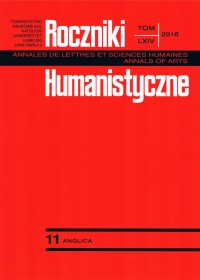Full agreement with coordinate subjects in Polish: Gender resolution rules revisited
Abstract
The aim of the paper is to propose a set of revised gender resolution rules for Polish, based on an interplay between gender and animacy features of conjuncts, which makes a coordinate subject eligible for a given variant of gender agreement with the predicate. Specifically, it is argued that both gender and animacy features of conjuncts can make a coordinate subject eligible for virile or non-virile agreement, or both. The resolution is achieved by the application of a set of four rules capitalising on certain semantic features of conjuncts and the interaction between them within a coordinate subject. The application of the rules restricts agreement possibilities to either virile or non-virile agreement, or makes both possibilities available for a given coordinate subject. In consequence, the proposed revised gender resolution rules have a capacity to capture data that are problematic under the traditional resolution rules for Polish.
References
Bogucka, Jadwiga. 2014. “Feature resolution and agreement with coordinated subjects in Polish”. In Complex visibles out there. Proceedings of the Olomouc Linguistics Colloquium 2014: Language use and linguistic structure, edited by Ludmila Veselovská and Markéta Janebová, 315–331. Olomouc: Palacký University.
Corbett, Greville. 1982. “Resolution rules for predicate agreement in the Slavonic languages.” The Slavonic and East European Review 60(3): 347–378.
Corbett, Greville. 1983. “The number of genders in Polish.” Papers and Studies in Contrastive Linguistics 16: 83-89.
Despić, Miloje. 2016. “Coordinating gender: What can coordinate structure agreement tell us about gender?” Studies in Polish Linguistics 11(1): 1–25.
Kramer, Ruth. 2015. The morphosyntax of gender. Oxford: Oxford University Press.
Laskowski, Roman. 1999. “Kategorie morfologiczne języka polskiego – Charakterystyka funkcjonalna.” In Gramatyka współczesnego jezyka polskiego. Morfologia, edited by Renata Grzegorczykowa, Roman Laskowski, and Henryk Wróbel, 151–224. Warszawa: Wydawnictwo Naukowe PWN.
Mańczak, Witold. 1956. “Ile jest rodzajów w języku polskim?” Język Polski 36(2): 116–121.
Przepiórkowski, Adam, Mirosław Bańko, Rafał Górski, and Barbara Lewandowska-Tomaszczyk. 2012. Narodowy Korpus Języka Polskiego. Warszawa: Wydawnictwo Naukowe PWN.
Rappaport, Gilbert. 2011. “Toward a multi-level theory of morphology: How Polish gender works.” In Generative investigations: Syntax, morphology, and phonology, edited by Piotr Bański, Beata Łukaszewicz, Monika Opalińska, and Joanna Zaleska, 166–197. Newcastle-upon-Tyne: Cambridge Scholars Publishing.
Saloni, Zygmunt, and Marek Świdziński. 2007. Składnia współczesnego języka polskiego. Warszawa: Wydawnictwo Naukowe PWN.
Topolińska, Zuzanna. 1984. “Składnia grupy imiennej.” In Gramatyka współczesnego języka polskiego. Składnia, edited by Zuzanna Topolińska, 301–393. Warszawa: Wydawnictwo Naukowe PWN.
Willim, Ewa. 2006. Event, individuation and countability. A Study with special reference to English and Polish. Kraków: Jagiellonian University Press
Willim, Ewa. 2012a. “Concord in Polish coordinate NPs as Agree.” In Slavic languages in formal grammar. Proceedings of FDSL 8.5, Brno 2010, edited by Markéta Ziková and Mojmír Docekal, 233–253. Frankfurt am Main: Peter Lang.
Willim, Ewa. 2012b. “On the feature valuation/interpretability biconditional in Minimalist Theory. The case of (un)interpretable gender.” In Sound structure and sense, edited by Edmund Gussmann. Eugeniusz Cyran, Henryk Kardela, and Bogdan Szymanek, 761–806. Lublin: Wydawnictwo KUL.
Zbróg, Piotr. 2012. Składnia podmiotu szeregowego we współczesnym języku polskim. Kraków: Libron.
Copyright (c) 2016 Roczniki Humanistyczne

This work is licensed under a Creative Commons Attribution-NonCommercial-NoDerivatives 4.0 International License.





